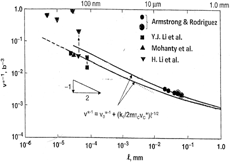Crossref Citations
This article has been cited by the following publications. This list is generated based on data provided by
Crossref.
Cui, Yinan
and
Ghoniem, Nasr
2019.
Influence of Size on the Fractal Dimension of Dislocation Microstructure.
Metals,
Vol. 9,
Issue. 4,
p.
478.
Armstrong, Ronald W.
2019.
Dislocation Mechanics Pile-Up and Thermal Activation Roles in Metal Plasticity and Fracturing.
Metals,
Vol. 9,
Issue. 2,
p.
154.
Armstrong, Ronald W.
and
Elban, Wayne L.
2020.
Crystal Strengths at Micro- and Nano-Scale Dimensions.
Crystals,
Vol. 10,
Issue. 2,
p.
88.
Chen, Xiang
Xia, Dabiao
Zhang, Junlei
Huang, Guangsheng
Liu, Ke
Tang, Aitao
Jiang, Bin
and
Pan, Fusheng
2020.
Ultrafine-grained Al–Zn–Mg–Cu alloy processed via cross accumulative extrusion bonding and subsequent aging: Microstructure and mechanical properties.
Journal of Alloys and Compounds,
Vol. 846,
Issue. ,
p.
156306.
Zubelewicz, Aleksander
2020.
Mechanisms-Based Transitional Viscoplasticity.
Crystals,
Vol. 10,
Issue. 3,
p.
212.
Smirnov, Ivan
and
Konstantinov, Alexander
2020.
Strain Rate Dependencies and Competitive Effects of Dynamic Strength of Some Engineering Materials.
Applied Sciences,
Vol. 10,
Issue. 9,
p.
3293.
Yu, Zhijie
Lin, Zhongya
and
Wei, Yueguang
2021.
Investigation on cross-scale indentation scaling relationships of elastic–plastic solids.
Acta Mechanica,
Vol. 232,
Issue. 4,
p.
1479.
Lei, Qian
Wang, Jian
and
Misra, Amit
2021.
Mechanical Behavior of Al–Al2Cu–Si and Al–Al2Cu Eutectic Alloys.
Crystals,
Vol. 11,
Issue. 2,
p.
194.
Valencia, Felipe J
Amigo, Nicolás
and
Bringa, Eduardo M
2021.
Tension–compression behavior in gold nanoparticle arrays: a molecular dynamics study.
Nanotechnology,
Vol. 32,
Issue. 14,
p.
145715.
Yu, Zhijie
Lin, Zhongya
and
Wei, Yueguang
2021.
Closed-form functions of cross-scale indentation scaling relationships based on a strain gradient plasticity theory.
Philosophical Magazine,
Vol. 101,
Issue. 11,
p.
1305.
Kang, Fangchao
Li, Yingchun
and
Tang, Chun'an
2021.
Grain size heterogeneity controls strengthening to weakening of granite over high-temperature treatment.
International Journal of Rock Mechanics and Mining Sciences,
Vol. 145,
Issue. ,
p.
104848.
Chien, Yu-An
Chen, Chun-Yi
Sone, Masato
and
Chang, Tso-Fu Mark
2022.
Sample size effect in Ni-TiO2 composites fabricated by supercritical CO2 emulsified CO-electroplating for miniaturized device.
Micro and Nano Engineering,
Vol. 15,
Issue. ,
p.
100135.
Chen, Yan
Li, Heng
Sun, Guixun
Han, Shuang
and
Lian, Jianshe
2022.
Unravelling the Size‐Dependent Mechanical Properties of Nanocrystalline Face‐Centered‐Cubic Metals: From the Dislocation Point of View.
Advanced Engineering Materials,
Vol. 24,
Issue. 12,
Halloran, Matthew W.
Danielczak, Lisa
Nicell, Jim A.
Leask, Richard L.
and
Marić, Milan
2022.
Highly Flexible Polylactide Food Packaging Plasticized with Nontoxic, Biosourced Glycerol Plasticizers.
ACS Applied Polymer Materials,
Vol. 4,
Issue. 5,
p.
3608.
Huang, Wei
Pan, Kailin
Wang, Bo
and
Gong, Yubing
2022.
Grain Size Effects on Mechanical Properties of Nanocrystalline Cu6Sn5 Investigated Using Molecular Dynamics Simulation.
Materials,
Vol. 15,
Issue. 11,
p.
3889.
Deluigi, Orlando
Valencia, Felipe
Tramontina, Diego R.
Amigo, Nicolás
Rojas-Nunez, Javier
and
Bringa, Eduardo M.
2023.
Influence of Grain Size on Mechanical Properties of a Refractory High Entropy Alloy under Uniaxial Tension.
Crystals,
Vol. 13,
Issue. 2,
p.
357.
Li, Qizhen
2023.
Geometrically Necessary Dislocation Analysis of Deformation Mechanism for Magnesium under Fatigue Loading at 0 °C.
Crystals,
Vol. 13,
Issue. 3,
p.
490.
Wang, Yubao
Zheng, Zebang
Zeng, Feng
and
Fu, Mingwang
2023.
Geometrical and microstructural size effects in progressive forming using wires.
International Journal of Mechanical Sciences,
Vol. 251,
Issue. ,
p.
108332.
Li, Xia
Luo, Xiaowu
Li, Pu
Huang, Yanyan
Yang, Jianping
and
Zhou, Qinghua
2024.
Size effect and indenter shape dependence of indentation and scratching behavior for laser melting deposited Ti-6Al-4V alloy.
Materials Science and Technology,





